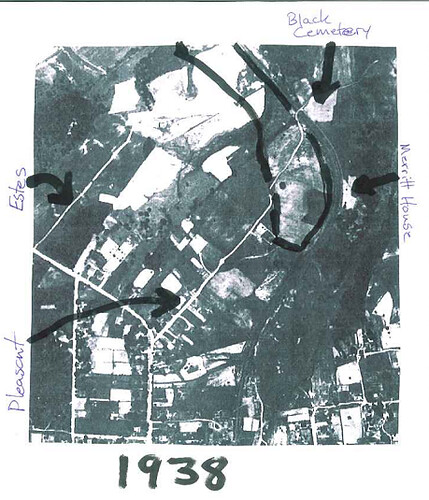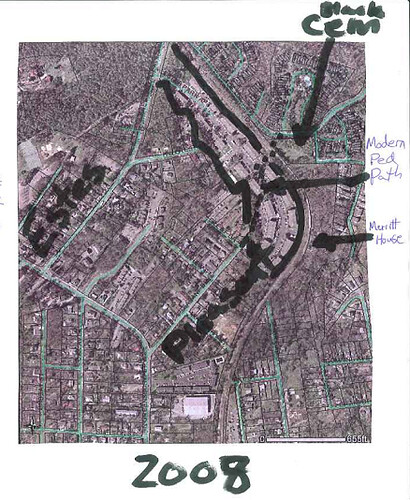This is a reworked version of an OrangePolitics.org post regarding a little pedestrian controversy that happened in Carrboro in the summer of 2008. Alas, neither the Town of Chapel Hill nor the Town of Carrboro were able to do much about that situation. But the issue brought to light a little bit of Carrboro history that I though folks might be interested in:
Area residents are concerned about the new fence blocking access between Estes Park Apartments in Carrboro and Village West Townhouses in Chapel Hill. The management of Estes Park erected a fence and gate, which is padlocked. The fence is 8' tall with three strands of barbed wire at the top. It blocks a traditional connection between the two neighborhoods and by extension connections from each neighborhood to downtown Carrboro and Chapel Hill.
Alderman Dan Coleman and I went out in July to look at the fence and realized that it blocks the driveway to the Leo Merritt property. Leo Merritt was a senior citizen who lived across the railroad tracks in a house that was built in the early 20th century. He got to his house by driving through Estes Park and across the railroad tracks. It was an odd set-up, but it had obviously been that way for a long time. It occurred to me that Mr. Merritt probably had an easement of some sort that allowed him to do this. And then I remembered that the Town of Chapel Hill bought Mr. Merritt's property (and therefore whatever easements he had) a few years ago as part of a major open space initiative.
So I spent a dusty afternoon in the Register of Deeds Office in Hillsborough and at the Carrboro Planning Department. A review of historic aerial photographs of Carrboro revealed that the Merritt railroad crossing has been there for a lot longer than Estes Park Apartments has. In fact, Estes Park clearly acknowledged the access point in 1971 when the apartments were built, as aerial photos show that there was a well-developed, formal crossing of the tracks there in 1973. My title search showed that Leo Merritt's father, J C Merritt, bought that property in the 1920's (Orange Co Deed Book 103, page 259). The house was probably built about that time.

The Merritt railroad crossing is plainly shown on an aerial photo from 1938. And the photo also shows that this crossing was at that time accessed from what is now Pleasant Street in Carrboro. The connection to Pleasant Street demonstrates that the current popular, but infromal connection from the end of Pleasant to Estes Park Apartments (on the opposite side of the property from the fence) is actually a very old and well established connection as well. Also, the photo shows that this route was at one time the primary access road for the old slave cemetery in Chapel Hill, which can still be seen just across from Village West on Village Drive.

So it seems clear that Estes Park Apartments is blocking a traditional right of way that has existed for more than 70 years, possibly more like 100 or 150 years. While I am sure that Estes Park Apartments is trying to address some valid security concerns, I believe that they are blocking an important and traditional footpath that has been in place for 70+ years.
Area residents are concerned about the new fence blocking access between Estes Park Apartments in Carrboro and Village West Townhouses in Chapel Hill. The management of Estes Park erected a fence and gate, which is padlocked. The fence is 8' tall with three strands of barbed wire at the top. It blocks a traditional connection between the two neighborhoods and by extension connections from each neighborhood to downtown Carrboro and Chapel Hill.
Alderman Dan Coleman and I went out in July to look at the fence and realized that it blocks the driveway to the Leo Merritt property. Leo Merritt was a senior citizen who lived across the railroad tracks in a house that was built in the early 20th century. He got to his house by driving through Estes Park and across the railroad tracks. It was an odd set-up, but it had obviously been that way for a long time. It occurred to me that Mr. Merritt probably had an easement of some sort that allowed him to do this. And then I remembered that the Town of Chapel Hill bought Mr. Merritt's property (and therefore whatever easements he had) a few years ago as part of a major open space initiative.
So I spent a dusty afternoon in the Register of Deeds Office in Hillsborough and at the Carrboro Planning Department. A review of historic aerial photographs of Carrboro revealed that the Merritt railroad crossing has been there for a lot longer than Estes Park Apartments has. In fact, Estes Park clearly acknowledged the access point in 1971 when the apartments were built, as aerial photos show that there was a well-developed, formal crossing of the tracks there in 1973. My title search showed that Leo Merritt's father, J C Merritt, bought that property in the 1920's (Orange Co Deed Book 103, page 259). The house was probably built about that time.

The Merritt railroad crossing is plainly shown on an aerial photo from 1938. And the photo also shows that this crossing was at that time accessed from what is now Pleasant Street in Carrboro. The connection to Pleasant Street demonstrates that the current popular, but infromal connection from the end of Pleasant to Estes Park Apartments (on the opposite side of the property from the fence) is actually a very old and well established connection as well. Also, the photo shows that this route was at one time the primary access road for the old slave cemetery in Chapel Hill, which can still be seen just across from Village West on Village Drive.

So it seems clear that Estes Park Apartments is blocking a traditional right of way that has existed for more than 70 years, possibly more like 100 or 150 years. While I am sure that Estes Park Apartments is trying to address some valid security concerns, I believe that they are blocking an important and traditional footpath that has been in place for 70+ years.
Unfortunately, it turns out that like so many African American landowners, Mr. Merritt probably had his access on the strength of a handshake. We never found any recorded easement and there doesn't appear to be much we can do to re-open this path.
You referred to this post during last night's discussion of
ReplyDeletehttp://www.ci.carrboro.nc.us/BoA/Agendas/2010/09_28_2010.htm
> 2. Continuation of the Public Hearing on Pedestrian and Bicycle Access Alternatives in the Estes Drive Area
so I wanted to followup regarding your comments at the meeting and in this post:
I live in downtown Carrboro, near Fitch. Unlike most, I am carfree. (Hopefully there will be more of us if the new development @ Weaver & Greensboro is properly transit-oriented.) When I wanna go to north CHill (e.g. Triangle Yoga, the Chelsea) I usually bike using N Greensboro St and Estes Dr. The bike/ped quality of Estes Dr NE of N Greensboro St is notorious, and I rue the day that the Carrboro powers-that-be decided not to complete Chapel Hill's improvements (which currently run on Estes Dr SW from MLK to Hillcrest Av or Tree Tops, depending on the side of the street) all the way to N Greensboro St.
Thus I was quite interested in the proposal discussed at last night's meeting (though apparently denigrated by Jeff Brubaker and the TAB) for a paved, improved connector between the current NW end of Pleasant Dr and the Estes Park Apartments drive. While suboptimal compared to a widened shoulder on Estes Dr (like Chapel Hill installed), if bikeable such a connector could, among other utilities, and at apparently quite low cost, provide a relatively direct connection between downtown and the improved portion of Estes Dr. (Which, for all its other advantages, the Wilson Park path would not. While I agree that the Wilson Park path is a good thing that the Town should build, it would be quite out-of-the-way for someone going from downtown to Estes and MLK.) Hence I spoke urging the Town to explore means to overcome the opposition of the Estes Park management (including condemnation) and build the damn thing.
During the discussion of this proposal, you showed this page, and (IIRC) suggested that the existence of the public ROW, if not previously explicitly abandoned, could allow for improvement of the presently informal path between Estes Park and Pleasant Dr. However, in this post, you say "there doesn't appear to be much we can do to re-open this path." These two positions seem divergent, no? If not, please explain how the positions agree. If so, please explain how/why your views have changed in the intervening 22 months.